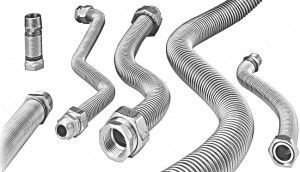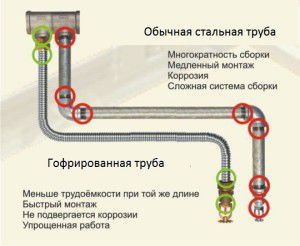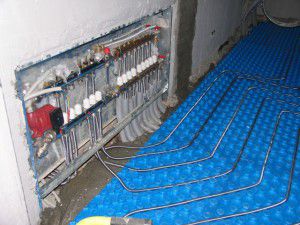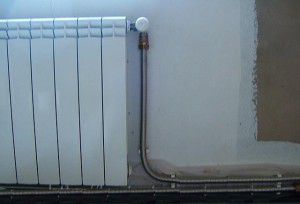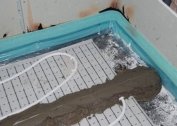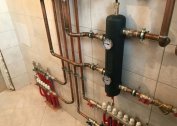Some heating schemes provide for complex sections of the highway in configuration. In fact, making them using steel or plastic pipes is problematic, and most often impossible. An alternative is stainless steel for heating: corrugation, corrugated pipe, corrugated pipe. What are its advantages, and what operational properties should be considered before installation?
Features of stainless steel corrugation for heating
It should be noted right away that not every corrugation stainless steel for heating is able to withstand the maximum allowable pressure in the system. This is due to the peculiarity of its design. For the manufacture of using steel sheet brand SUS304. After molding, a pipe is formed using a special welding mode. In the future, it is subjected to additional firing, which gives it the desired degree of reliability, mechanical strength, elasticity.
The main advantage that a corrugated stainless steel pipe should have for heating is the ability to bend to the minimum radius value. It can be 1-1.5 diameters of the product. Also, when choosing, you need to consider such parameters:
- High-quality corrugation stainless steel pipe for heating must withstand an average pressure value of up to 15 atm., Maximum - up to 50 atm;
- Temperature condition - from -50 to 110 ° С;
- The degree of elongation is small - up to 2-3% of the total length;
- The presence of connecting components at the ends.
The latter is relevant if the length of the section of the trunk section where the pipe will be installed is known exactly. If this parameter is not accurate, corrugated stainless steel is best suited for heating in bays. Their maximum length is 50 m.
A significant drawback of corrugated stainless steel for heating is its cost. Therefore, it is not recommended to make the entire system out of it - it is enough to install it on complex parts of the system.
Corrugated Pipe Application
The main criterion for choosing a corrugation from stainless steel for heating is its quality and properties of the starting material. The presence of external signs of deformation, creases or traces of corrosion is not allowed. But more difficult is checking the quality of welding - the durability of operation depends on it. On average, subject to the installation rules, a corrugated stainless steel pipe for heating can last up to 20 years.
It is also recommended that you read the certificates of conformity that sellers must have. Their availability will confirm the quality and manufacturer. Additional criteria are determined by the type of corrugation:
- With number length. Fittings must be fully equipped;
- With arbitrary length. It is necessary to check the quality of the cut. The edges of the pipe cannot be damaged.
Each stainless steel corrugated pipe for heating has a specific diameter. It has a standard size so that additional hydraulic resistance does not occur in a particular section of the highway. To calculate the volume of coolant that can accommodate a stainless steel pipe for heating at 1 mp You can use the data from the table.
| Inner diameter mm | Volume, l./m.p. | Area (m²) 1 sq.m. |
| 15 | 0,219 | 0,0646 |
| 20 | 0,447 | 0,095 |
| 25 | 0,71 | 0,12 |
| 32 | 0,982 | 0,15 |
The scope of the corrugation of a stainless steel pipe for heating is diverse. In addition to complex sections of the main, it can also be installed in other heating elements.
During installation, do not stretch the pipe to the maximum length. This can cause its premature destruction due to excessive surface load.
Stainless steel underfloor heating
The main property of stainless steel is its high corrosion resistance. Given the flexibility, high temperature and maximum pressure, most often a corrugated stainless steel pipe for heating is used to organize a warm floor.
The advantage of this scheme is a high rate of thermal conductivity of the pipe. It is able to evenly warm up the concrete surface of 10 cm screeds. For installation, it is best to use special mats with guide recesses.
Basic installation rules:
- The distance between the turns, at which the maximum efficiency is achieved - 20 cm;
- Corrugation of a corrugated pipe from a stainless steel for heating in individual sections is not allowed. Thus, surface tension arises which can lead to damage;
- Installation with additional polymer covers is not recommended. They will not increase strength, but will lead to a decrease in heat transfer.
Cutting a pipe from stainless steel for heating can be done using the "grinder". To do this, fix the product with clamps or bench vices.
For stainless steel corrugated pipes for heating, you need to purchase special fittings. Their design is designed for mounting on an uneven outer surface.
Corrugated pipe access to heaters
Due to its flexibility, stainless steel corrugated pipe for heating can also be used to connect radiators. With its help, you can minimize the complexity of installation and reduce the length of the entire highway.
One of the disadvantages of such a connection is the complexity of manufacturing a bypass assembly. Installing shutoff valves will be problematic.
Unlike the underfloor heating system, corrugated stainless steel must be carefully insulated before installation in heating. Large heat losses will reduce work efficiency and lead to an uneven distribution of thermal energy throughout the house.
Installation technology consists in observing the following steps:
- Using a grinder or a special pipe cutter, a corrugated stainless steel pipe is cut for subsequent installation in heating;
- Installation of a previously selected fitting. To fix with the surface, tighten the nut. It is important to control the force - pipe damage or deformation is possible;
- After the final installation, the tightness of the assembly is checked.
To select a high-quality stainless steel corrugated pipe for a heating system, it is recommended to purchase products from trusted manufacturers. Currently they are Kofulso, Lavita and EasyFlex. The average cost of their products ranges from 160 to 270 rubles / m.
What else needs to be considered when choosing and installing a stainless steel for heating: corrugations, corrugated pipes, corrugated? Due to the properties of the material of manufacture, limescale will practically not form on the inner surface. This will significantly increase the time between mandatory cleaning of the heating system.
The video shows a comparison of a corrugated metal pipe with its analogues:
